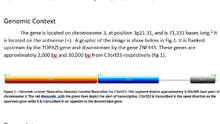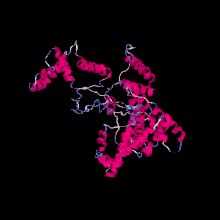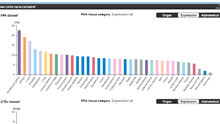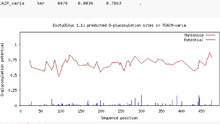C3orf23
| TCAIM | |||||||
|---|---|---|---|---|---|---|---|
| Identifiers | |||||||
| Aliases | TCAIM, C3orf23, TOAG-1, TOAG1, T-cell activation inhibitor, mitochondrial | ||||||
| External IDs | MGI: 1196217 HomoloGene: 45481 GeneCards: TCAIM | ||||||
| Orthologs | |||||||
| Species | Human | Mouse | |||||
| Entrez | |||||||
| Ensembl | |||||||
| UniProt | |||||||
| RefSeq (mRNA) |
| ||||||
| RefSeq (protein) |
| ||||||
| Location (UCSC) | Chr 3: 44.34 – 44.41 Mb | Chr 9: 122.81 – 122.84 Mb | |||||
| PubMed search | [1] | [2] | |||||
| Wikidata | |||||||
| |||||||
Uncharacterized protein C3orf23 is a protein that in humans is encoded by the C3orf23 gene.[3][4] Also known as TCAIM (T-cell activation inhibitor, mitochondrial).
Gene
The gene is located on chromosome 3, at position 3p21.31, and is 71,333 bases long. A graphic of the image is show below in Fig.1.2 The TCAIM protein is 496 residues long and weighs 57925 Da. It exists in four different isoforms. TCAIM is highly conserved among different species of organism, but no homologies to protein families of known functions were discovered.[5]
Transcript
There are 8 alternatively spliced exons, which encode 4 transcript variants. The primary transcript, which is 3520 bp, is well conserved among orthologs, with the human isoform 1 having high identity with orthologous proteins. The X1 transcript contauns 11 exons, which yield a polypeptide that is 496 amino acid residues in length.[6]

Protein
General Properties
| Property | Pre-Protein | Cleaved Protein | Mature Protein |
|---|---|---|---|
| Amino Acid Length | 496 | 470 | 470 |
| Isoelectric Point | 8.7 | 8.5 | 8.2-8.6 |
| Molecular Weight | 58 kdal | 55 kdal | ~55-57 |
The isoelectric point is significantly greater than average for human proteins (6.81).[7]
Structure
Shown to the right is a predicted tertiary structure of the protein. It is composed mostly of long alpha-helices with several coil regions and strands dispersed throughout the length of the protein. The ends of the protein consist of coil regions opposite the N- and C- terminal ends.

Expression
TCAIM is moderately expressed (50-75%) in most tissues in the body.[9] However, a study on NCBI GEO discussing the effect of disease states on TCAIM mRNA expression found that protein expression was actually elevated in HPV positive tissues compared to the HPV negative tissues. Another study found that TCAIM expression was elevated in individuals with Type 2 diabetes and insulin resistance. The expression of TCAIM seems to be contingent on the specific disease state in a variety of cases.[10]

Subcellular Localization
The protein contains a mitochondrial signal peptide localizing it to the mitochondrial matrix.[11] Analysis the EXPASY localization software[12] confirmed this finding. The high isoelectric point of the Human protein provides further evidence for the mitochondrial localization due to the high pH of the mitochondrial matrix.
Post-translational Modifications
Cleavage cites
The protein is initially cleaved to remove the 26 amino acids from the N-terminus. This represents a signal peptide after it is localized to the mitochondrion.[11]
Phosphorylation
There are a number of predicted phosphorylation sites, as see in the figure to the right. Serine residues are more likely to undergo phosphorylation than threonine or tyrosine residues.

O-linked glycosylation
Shown to the right are a number of predicted o-linked sites. None have been experimentally determined thus far.

Homology and Evolution
Homologs
An alignment of Homo sapiens TCAIM and Danio rerio (Zebrafish) homologs was performed using the SDSC workbench. There is approximately 55% identity between the two orthologs, with a global alignment score of 1817. The two orthologs are consistently similar throughout the entirety of their sequences. The differences between the two genes is due seemingly random segments of non-conserved and semiconserved residues scattered throughout the two alignments. This difference may be due to the non-relatedness between the two organisms.[15]

Evolutionary History
TCAIM diverged much quicker than cytochrome C, but slightly slower than fibrinogen.[16]
Function
Not much is known about the function; it is surmised that this protein may play a role in T-cell apoptosis. TCAIM may play a role in the innate immune signaling via the mitochondria.[17]
Clinical Significance
A research study performed by Vogel et al. They previously found that TCAIM is highly expressed in grafts and tissues of tolerance-developing transplant patients and that the protein is localized in the mitochondria. In this study, they found that TCAIM interacts with and is regulated by CD11c(+) dendritic cells.[17] Another article by Hendrikson et. el briefly mentions TCAIM. They found that Genetic variants in nuclear-encoded mitochondrial genes influence AIDS progression.[5] The third article is another research that finds evidence that TCAIM (along with mitochondrial genes could be used as a marker in patients to predict whether they could accept an allograft or reject it.[18]
References
- ↑ "Human PubMed Reference:".
- ↑ "Mouse PubMed Reference:".
- ↑ Strausberg RL, Feingold EA, Grouse LH, Derge JG, Klausner RD, Collins FS, Wagner L, Shenmen CM, Schuler GD, Altschul SF, Zeeberg B, Buetow KH, Schaefer CF, Bhat NK, Hopkins RF, Jordan H, Moore T, Max SI, Wang J, Hsieh F, Diatchenko L, Marusina K, Farmer AA, Rubin GM, Hong L, Stapleton M, Soares MB, Bonaldo MF, Casavant TL, Scheetz TE, Brownstein MJ, Usdin TB, Toshiyuki S, Carninci P, Prange C, Raha SS, Loquellano NA, Peters GJ, Abramson RD, Mullahy SJ, Bosak SA, McEwan PJ, McKernan KJ, Malek JA, Gunaratne PH, Richards S, Worley KC, Hale S, Garcia AM, Gay LJ, Hulyk SW, Villalon DK, Muzny DM, Sodergren EJ, Lu X, Gibbs RA, Fahey J, Helton E, Ketteman M, Madan A, Rodrigues S, Sanchez A, Whiting M, Madan A, Young AC, Shevchenko Y, Bouffard GG, Blakesley RW, Touchman JW, Green ED, Dickson MC, Rodriguez AC, Grimwood J, Schmutz J, Myers RM, Butterfield YS, Krzywinski MI, Skalska U, Smailus DE, Schnerch A, Schein JE, Jones SJ, Marra MA (Dec 2002). "Generation and initial analysis of more than 15,000 full-length human and mouse cDNA sequences". Proc Natl Acad Sci U S A. 99 (26): 16899–903. PMC 139241
 . PMID 12477932. doi:10.1073/pnas.242603899.
. PMID 12477932. doi:10.1073/pnas.242603899. - ↑ "Entrez Gene: C3orf23 chromosome 3 open reading frame 23".
- 1 2 Hendrickson SL, Lautenberger JA, Chinn LW, Malasky M, Sezgin E, Kingsley LA, Goedert JJ, Kirk GD, Gomperts ED, Buchbinder SP, Troyer JL, O'Brien SJ (2010). "Genetic variants in nuclear-encoded mitochondrial genes influence AIDS progression". Plos One. 5 (9): e12862. PMC 2943476
 . PMID 20877624. doi:10.1371/journal.pone.0012862.
. PMID 20877624. doi:10.1371/journal.pone.0012862. - ↑ https://www.ncbi.nlm.nih.gov/gene/285343
- ↑ Kozlowski, Lukasz P. "Proteome-pI - Proteome Isoelectric Point Database statistics". isoelectricpointdb.org. Retrieved 2017-04-30.
- ↑ J Yang, R Yan, A Roy, D Xu, J Poisson, Y Zhang. The I-TASSER Suite: Protein structure and function prediction. Nature Methods, 12: 7-8, 2015.
- 1 2 Uhlén M et al, 2015. Tissue-based map of the human proteome. Science PubMed: 25613900 DOI: 10.1126/science.1260419
- ↑ https://www.ncbi.nlm.nih.gov/geo/tools/profileGraph.cgi?ID=GDS161:RC_N95260_at
- 1 2 http://www.genecards.org/cgi-bin/carddisp.pl?gene=TCAIM
- ↑ https://www.expasy.org/proteomics/post-translational_modification
- ↑ Zexian Liu, Yongbo Wang, Han Cheng, Wankun Deng, Zhicheng Pan, Shahid Ullah, Jian Ren and Yu Xue. 2015, Submitted
- ↑ Precision mapping of the human O-GalNAc glycoproteome through SimpleCell technology. Steentoft C, Vakhrushev SY, Joshi HJ, Kong Y, Vester-Christensen MB, Schjoldager KT, Lavrsen K, Dabelsteen S, Pedersen NB, Marcos-Silva L, Gupta R, Bennett EP, Mandel U, Brunak S, Wandall HH, Levery SB, Clausen H. EMBO J, 32(10):1478-88, May 15, 2013. (doi: 10.1038/emboj.2013.79. Epub 2013 Apr 12)
- ↑ Myers EW, Miller W (1988). "Optimal alignments in linear space". Computer Applications in the Biosciences. 4 (1): 11–7. PMID 3382986. doi:10.1093/bioinformatics/4.1.11.
- ↑ https://genome.ucsc.edu/index.html%5B%5D
- 1 2 Vogel SZ, Schlickeiser S, Jürchott K, Akyuez L, Schumann J, Appelt C, Vogt K, Schröder M, Vaeth M, Berberich-Siebelt F, Lutz MB, Grütz G, Sawitzki B (2015). "TCAIM decreases T cell priming capacity of dendritic cells by inhibiting TLR-induced Ca2+ influx and IL-2 production". Journal of Immunology. 194 (7): 3136–46. PMID 25750433. doi:10.4049/jimmunol.1400713.
- ↑ Sawitzki B, Bushell A, Steger U, Jones N, Risch K, Siepert A, Lehmann M, Schmitt-Knosalla I, Vogt K, Gebuhr I, Wood K, Volk HD (2007). "Identification of gene markers for the prediction of allograft rejection or permanent acceptance". American Journal of Transplantation. 7 (5): 1091–102. PMID 17456197. doi:10.1111/j.1600-6143.2007.01768.x.
External links
- Human TCAIM genome location and TCAIM gene details page in the UCSC Genome Browser.
Further reading
- Mehrle A, Rosenfelder H, Schupp I, et al. (2006). "The LIFEdb database in 2006". Nucleic Acids Res. 34 (Database issue): D415–8. PMC 1347501
 . PMID 16381901. doi:10.1093/nar/gkj139.
. PMID 16381901. doi:10.1093/nar/gkj139. - Wiemann S, Arlt D, Huber W, et al. (2004). "From ORFeome to Biology: A Functional Genomics Pipeline". Genome Res. 14 (10B): 2136–44. PMC 528930
 . PMID 15489336. doi:10.1101/gr.2576704.
. PMID 15489336. doi:10.1101/gr.2576704. - Gerhard DS, Wagner L, Feingold EA, et al. (2004). "The Status, Quality, and Expansion of the NIH Full-Length cDNA Project: The Mammalian Gene Collection (MGC)". Genome Res. 14 (10B): 2121–7. PMC 528928
 . PMID 15489334. doi:10.1101/gr.2596504.
. PMID 15489334. doi:10.1101/gr.2596504. - Ota T, Suzuki Y, Nishikawa T, et al. (2004). "Complete sequencing and characterization of 21,243 full-length human cDNAs". Nat. Genet. 36 (1): 40–5. PMID 14702039. doi:10.1038/ng1285.
- Simpson JC, Wellenreuther R, Poustka A, et al. (2001). "Systematic subcellular localization of novel proteins identified by large-scale cDNA sequencing". EMBO Rep. 1 (3): 287–92. PMC 1083732
 . PMID 11256614. doi:10.1093/embo-reports/kvd058.
. PMID 11256614. doi:10.1093/embo-reports/kvd058. - Wiemann S, Weil B, Wellenreuther R, et al. (2001). "Toward a Catalog of Human Genes and Proteins: Sequencing and Analysis of 500 Novel Complete Protein Coding Human cDNAs". Genome Res. 11 (3): 422–35. PMC 311072
 . PMID 11230166. doi:10.1101/gr.GR1547R.
. PMID 11230166. doi:10.1101/gr.GR1547R. - Hartley JL, Temple GF, Brasch MA (2001). "DNA Cloning Using In Vitro Site-Specific Recombination". Genome Res. 10 (11): 1788–95. PMC 310948
 . PMID 11076863. doi:10.1101/gr.143000.
. PMID 11076863. doi:10.1101/gr.143000.